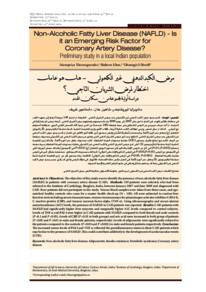Document
Non-alcoholic fatty liver disease (NAFLD) : is it an emerging risk factor for coronary artery disease? : preliminary study in a local Indian population.
Contributors
Khan, Shaheen., Author
Sheriff, Dhastagir S., Author
Other titles
مرض الكبد الدهني غير الكحولي- هل هو عامل اختطار لمرض الشريان التاجي؟ : دراسة أولية لمجموعة من سكان الهند
Publisher
College of Medicine, Sultan Qaboos University.
Gregorian
2010-08
Language
English
Subject
English abstract
Objectives: The objective of this study was to identify the presence of non-alcoholic fatty liver disease (NAFLD) in patients with coronary artery disease (CAD). Methods: 149 patients were selected, who had been referred to the Institute of Cardiology, Banglore, India, between January 2007 and June 2009 and diagnosed with CAD. Four patients did not participate in the study. Venous blood samples were taken from these cases, and age-matched healthy controls who came for a master health check-up (N = 100). All were subjected to routine liver function tests including serum transaminases, enzyme immunoassays for plasminogen activator inhibitor I (PAI-I), C reactive protein (CRP), and tumour necrosis factor-alpha (TNF-α). Using ultrasonography and serum alanine aminotransferase (ALT) levels, the presence of NAFLD in CAD patients was reported. Results: CAD patients with NAFLD had significantly higher liver enzymes and marginally higher A1C levels compared to control subjects. Levels of TNF-α and PAI-I were higher in CAD patients with NAFLD compared to both female and male controls (P <0.1 and P <0.05). Levels of CRP (P <0.01 in both groups) and uric acid were increased in both group of patients (P <0.05 and P <0.01 in male and female patients, respectively). Levels of adiponectin were significantly reduced in the patients compared to the controls (P <0.05 and P <0.001) in male and female patients respectively. Conclusion: The increased serum levels of PAI-I and TNF-α reflected the proinflammatory status in these CAD patients which may be due to the presence of NAFLD. This could contribute additively to the development of cardiovascular events (CVD).
Member of
Resource URL
Citation
Thiruvagounder, Manopriya, Khan, Shaheen, & Sheriff, Dhastagir S. (2010). Non-Alcoholic Fatty Liver Disease (NAFLD) - Is it an Emerging Risk Factor for Coronary Artery Disease? : Preliminary study in a local Indian population. Sultan Qaboos University Med
Arabic abstract
الهدف: تحديد وجود مرض الكبد الدهني غير الكحولي عند مرضى الشريان التاجي . الطريقة تم اختيار 149 مريضا أحيلوا إلى معهد القلب في منطقة بانجلور بالهند في الفترة ما بين يناير 2007 إلى يونيو 2009. وتم تشخيصهم بإصابتهم بمرض الشريان التاجي . أربعة مرضى لم يشاركوا في الدراسة. تم أخذ عينات دم وريدي من المرضى المشاركين ومن عينة ضابطة 100 شخصا من الذين ترددوا لأداء الفحص الطبي الدوري . متوافقة أعمارهم مع المرضى. كذلك تم عمل فحص روتيني لوظائف الكبد شاملا أنزيمات ناقلات الأمين وإنزيم المقايسة المناعية لمثبط منشط البلازمينوجين (I) والبروتين المتفاعل (ج) وعامل نخر الورم (ألفا). وباستخدام تخطيط الصَّدَى وقياس مستوى أنزيم ناقلة أمين الالانين في المصل تم تحديد وجود مرض الكبد الدهني غير الكحولي عند مرضى الشريان التاجي. النتائج: وجد لدى مرضى الشريان التاجي الذين يعانون من مرض الكبد الدهني غير الكحولي مستويات مرتفعة أنزيمات الكبد مع ارتفاع طفيف بمستوى (AIC) مقارنة بمستويات العينة الضابطة. كانت مستويات عامل نخر الورم (ألفا) وكذلك إنزيم المقايسة المناعية لمثبط منشط البلازمينوجين (I) أعلى لدى مرضى الشريان التاجي والكبد الدهني غير الكحولي مقارنة بمستويات العينة الضابطة بدرجة معتدة إحصائيا (0.05>P<0.1,P) في كل من المرضى الإناث والذكور. كان مستوى البروتين المتفاعل (ج) (0.01>P في المجموعتين) وكذلك حمض اليوريك أعلى في المجموعتين من المرضى (0.01>P<0.05,P في المرضى الذكور والإناث على التوالي). كما كانت مستويات الاديبونكتين منخفضة بشكل كبير في المرضى مقارنة بالعينة الضابطة (0.001>P<0.05, P في المرضى الذكور والإناث على التوالي. الخلاصة زيادة مستوى كل من إنزيم المقايسة المناعية لمثبط من منشط البلازمينوجين (I) وعامل نخر الورم (ألفا) في المصل عكس حالة الاستعداد للالتهاب في هؤلاء المرضى والذي قد يكون بسبب وجود مرض الكبد الدهني غير الكحولي. وهذا قد يساهم بشكل إضافي في نشوء أمراض القلب والأوعية الدموية.
Category
Journal articles

